New guns, new magazines, even new helmets. But they can’t get their magazines in their pouches. Thankfully, there’s a Gunner to show the way.
New guns, new magazines, even new helmets. But they can’t get their magazines in their pouches. Thankfully, there’s a Gunner to show the way.
The cornerstone of SOTECH’s massive product catalog has always been their medical line, and their crowning achievement was having their designs selected to fill most of the nylon carriage systems in the Special Forces Medic’s Tac Set over the last decade. After a year of design and sampling with SOF medics from around the globe, SOTECH has emerged from the design studio to present its next iteration of the Tactical Medical Modular Carriage System (Gen II). It was an honor to be given the opportunity to take a system carried by SOF personnel going downrange during the GWOT (SOTECH’s owner, Jim Cragg, was included when he deployed in 2007). And it’s an honor to be asked to take these battle-tested designs and modernize them with lighter high tech materials, minimized designs, and contoured shapes. SOTECH’s first generation of this modular system evolved into the RUCK – TRUCK – HOUSE concept, which guided this new system. The salient feature that runs across the entire TMMCS-II is universal modularity. The SOF medic is issued the set of loop-lined packs, bags and pouches with a set of hook-backed modular pouches and panels. Combinations of hook and MOLLE backing allow some pouches to be removed from the inside and mounted to the outside adding capacity. And the medic harness has shifted from a chest harness to a belt harness with a spin around feature congruent with the MARCH protocols. Also in the 2018 catalog are other new items including the Tourniquet Rapid Pouch, Zoll Difribrilator/Monitor Pack, and Medic’s Sharps Resistant Dump Pouch.
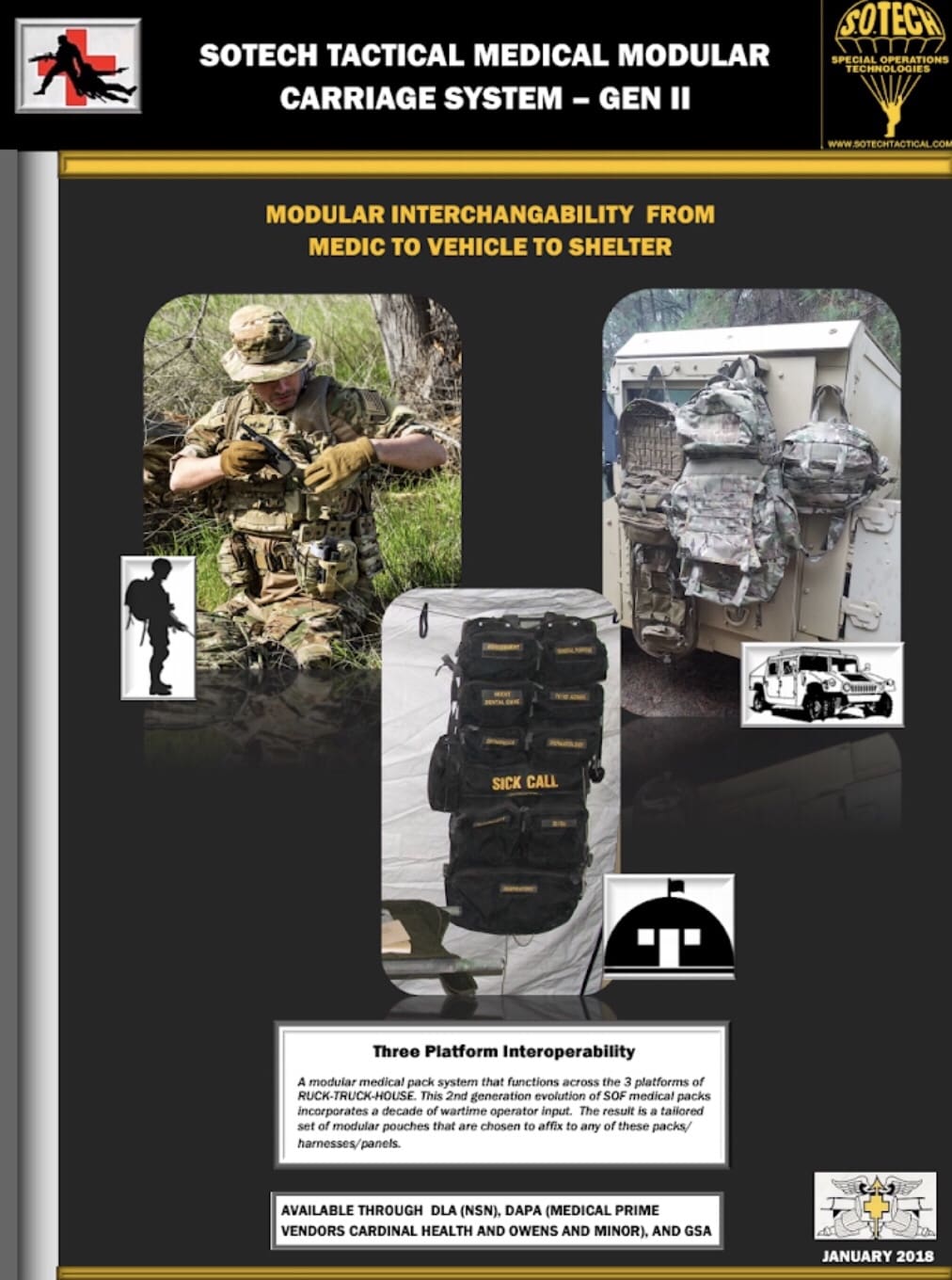
Check them all out next week at the SOMA conference in Charlotte. Most of the TMMCS-II items have been submitted for NSNs and will be available through DLA and medical prime vendors (via DAPA), and all items are available on SOTECH’s GSA schedule.
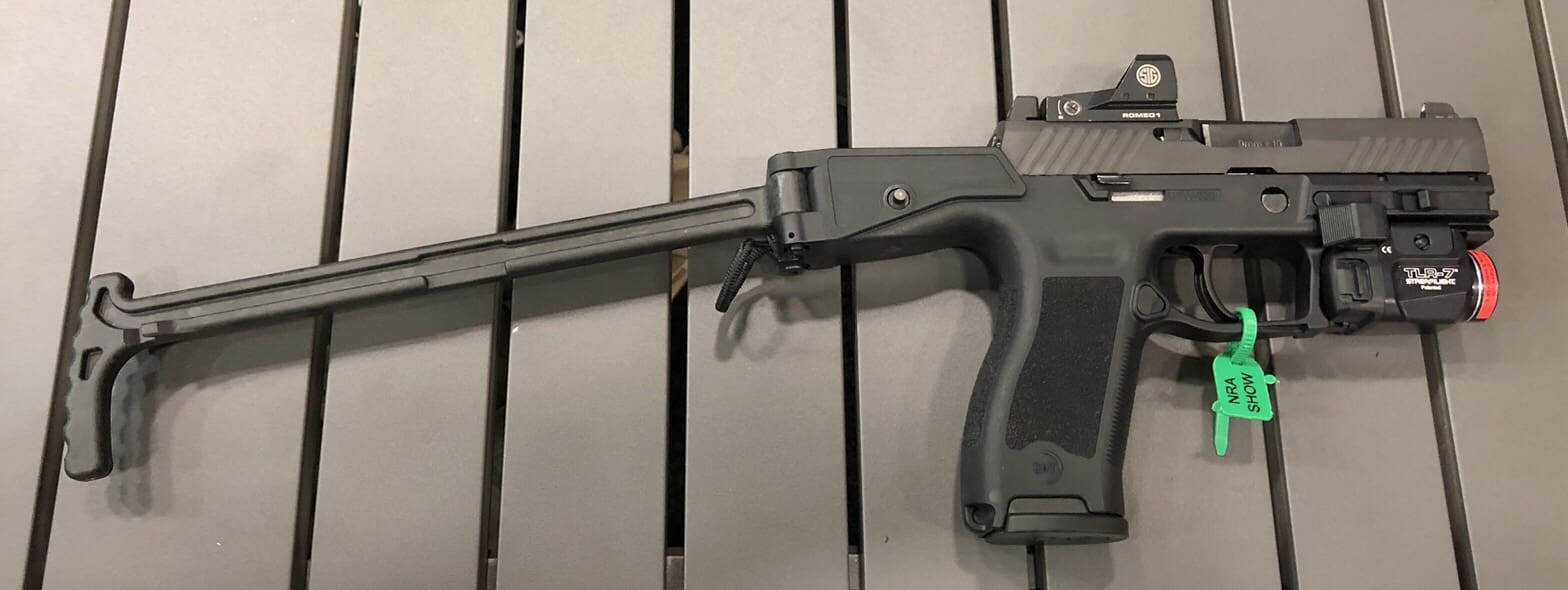
Released earlier this year, the USW-320 is based on B&T’s Universal Service Weapon, except that it’s a drop in lower receiver for the SIG P320 Fire Control Unit and Slide rather than a full firearm. Like the USW, it incorporates a right-side, fixed-length, side-folding stock.
As more and more organizations adopt the P320, this offers a more stable platform for those longer shots.
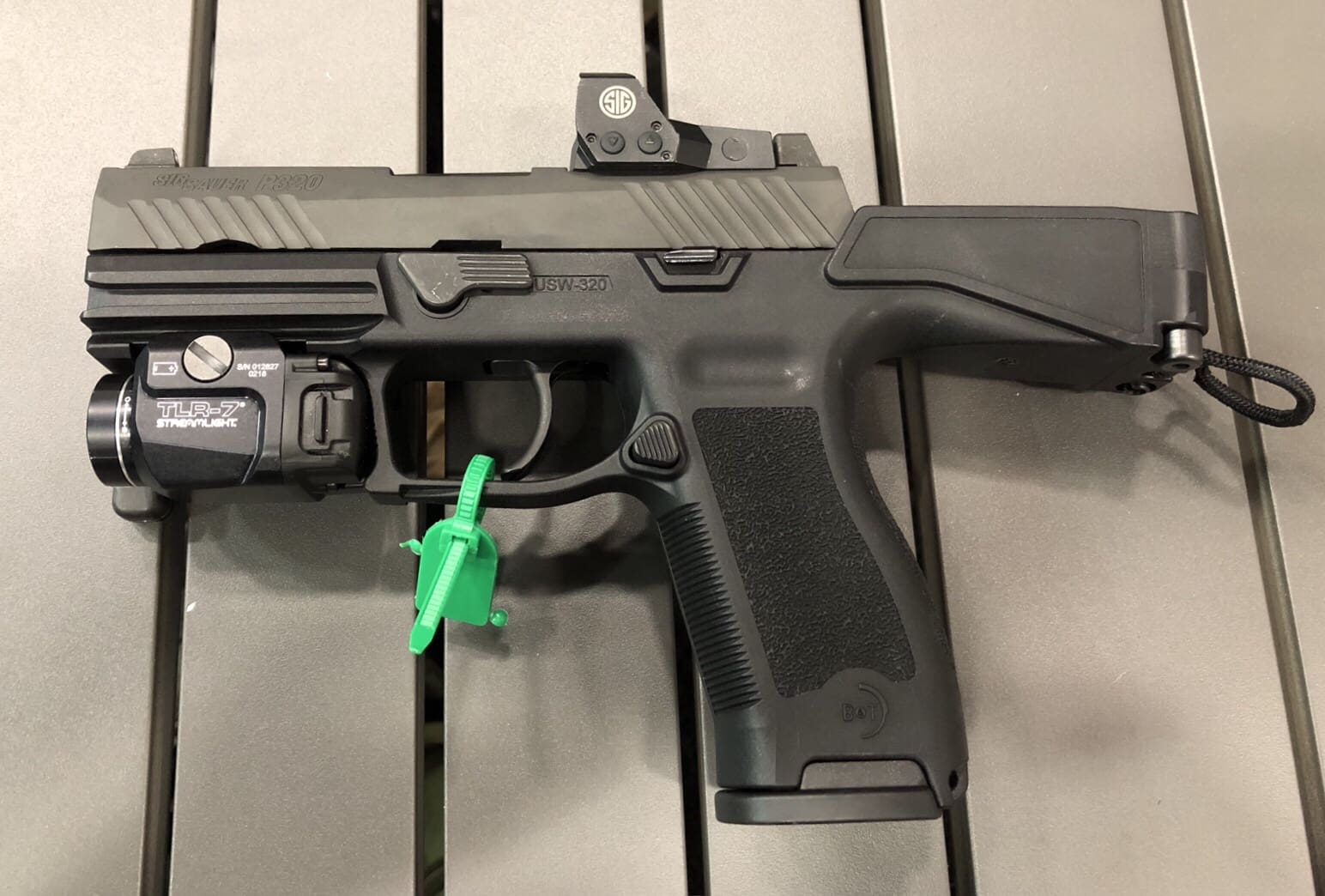
The USW 320 is pretty bare bones. You must also install a P320 magazine release. Additionally, a red dot optic can be mounted, but it has to be on the P320 slide you’ve provided. Hopefully, this spartan approach will keep the cost down so more people can take advantage of it.
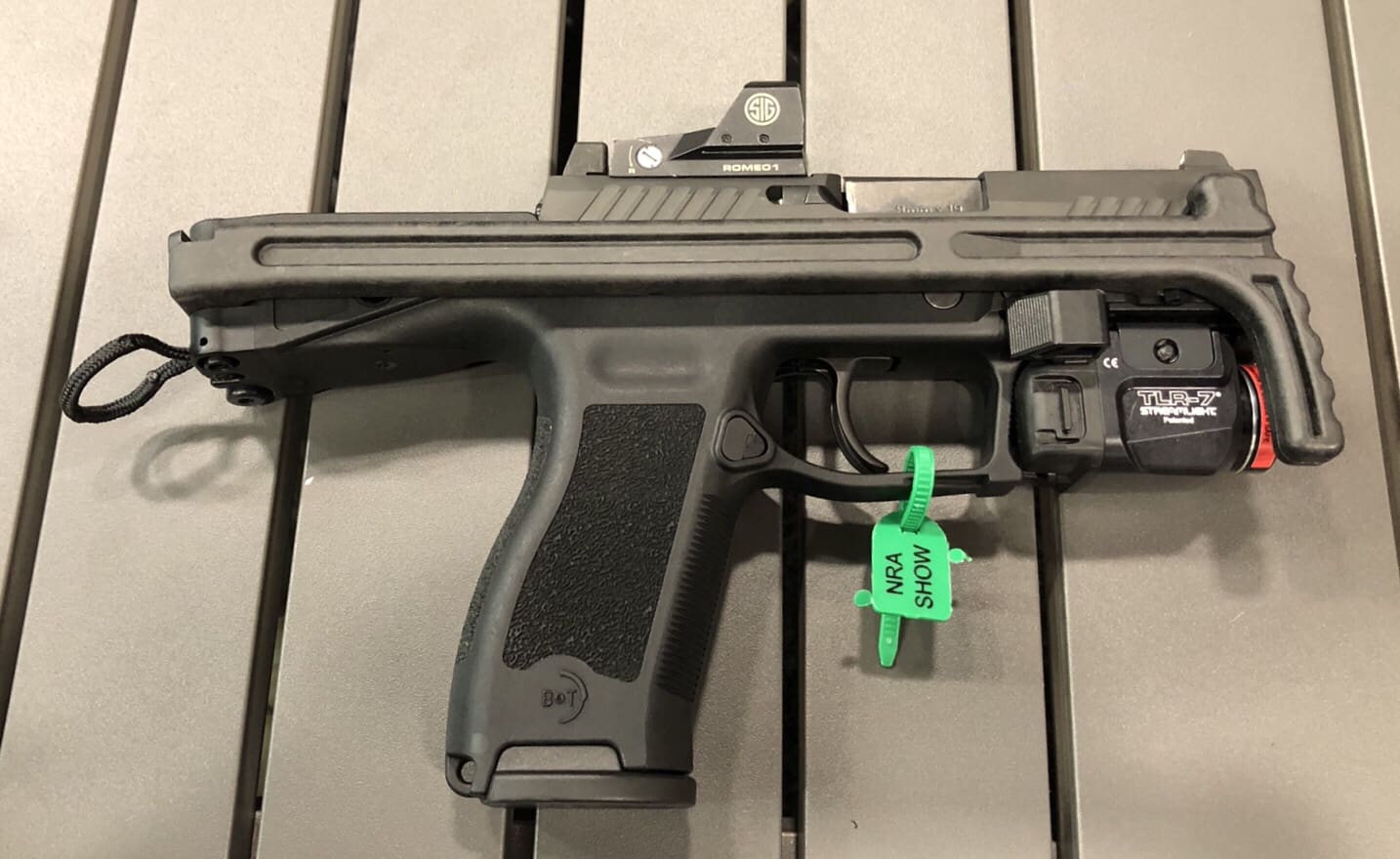
Earlier this year, the Army conducted a Limited User Evaluation of the Squad Designated Marksman Rifle. Based on the M110A1 Compact Semi Automatic Sniper System program, SDMR consists of a 7.62 NATO G28 rifle built by Heckler & Koch, equipped with an OSS Suppressor and Harris Bipod. The missing piece was the optic.
The Army’s Program Manager for Soldier Weapons invited industry, through the Tailored Logistics Support program, to submit 1-6x variable optics for the evaluation. They selected the SIG Optics TANGO6 1-6x Optic. It is a front focal optic and may recall that we previously covered this scope during Enforce Tac. Please note that this is not the mount which will be used on SDMR.
This optic was chosen specifically for the SDMR and as of now, the Directed Requirement is 6,069 systems. Funding is set for FY19.
The commercial TANGO6 optic was used by the Army Marksmanship Unit’s Daniel Horner during his win at this year’s USPSA Tactical Division. This marks his 10th win.
Update: We received this information from SIG SAUER.
“It’s truly an honor to be selected as the official optic for the Squad Designated Marksman Rifle, and it is very humbling to once again earn the trust of the US Army through this selection,” said Ron Cohen, President and CEO, SIG SAUER, Inc. “SIG SAUER is committed to providing the highest quality equipment for the military that surpasses expectations in durability, accuracy, and performance, so they have tools they can rely on for every mission requirement in the defense of freedom.”
The ruggedized SDMR TANGO6 1-6×24 riflescope features a Flat Dark Earth (FDE) anodized aircraft grade aluminum maintube, 762 Extended Range Bullet Drop Compensation (BDC) illuminated front focal plane reticle, an ultra-bright red horseshoe dot for fast daylight target acquisition, locking illumination dial, Power Selector Ring (PSR) Throw Lever, and a laser-marked scope level indicator for mount installation. The TANGO6 1-6X24 SDMR optic is a variant of SIG SAUER Electro-Optics commercially available TANGO6.
“SIG SAUER Electro-Optics fuses superior optical designs, advanced electronic technologies, and ruggedized mechanical systems tested to MIL-STD-810G at our R&D and assembly facility in Oregon, USA,” added Andy York, President SIG SAUER Electro-Optics. “We are firmly committed to supporting the US ARMY with this mission-specific riflescope that bridges the gap between close-quarters battle and mid-range tactical engagements.”
During NDIA’s Annual Armaments Meeting, Lt Col Christopher Woodburn (USMC, Ret), the Deputy, Maneuver Branch, Capabilities Development Directorate, discussed Marine Corps modernization efforts. He began by reiterating that Commandant of the Marine Corps, Gen Robert Neller’s priority remains the Infantry regarding small arms.
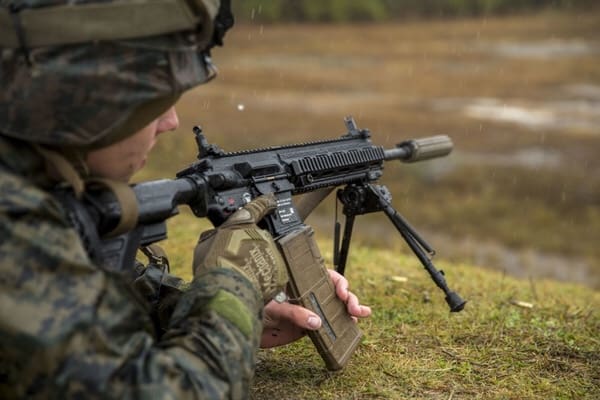
U.S. Marines with 3rd Battalion 8th Marine Regiment fire the M27 Infantry Automatic Rifle during a live-fire weapons exercise at range F-18 on Camp Lejeune, North Carolina in 2017. (Lance Cpl. Michaela R. Gregory/ Marine Corps)
Next, he mentioned the recent M27 contract and clarified that the M27 Infantry Automatics Rifle would be fielded to the entire Rifle Platoon from the Platoon Commander on down. Fielding will begin in FY18 and continue through FY20.
The M4s displaced by the M27 fielding will be used to replace remaining M16A4s in the Ground Combat Element.
Additionally, he explained that the M38 Designated Marksman Rifle variant of the M27 was a Squad element weapon and that the Squad leader would assign it to his best marksman. Marines have also begun receiving the Squad Range Finder to improve target acquisition and engagement.
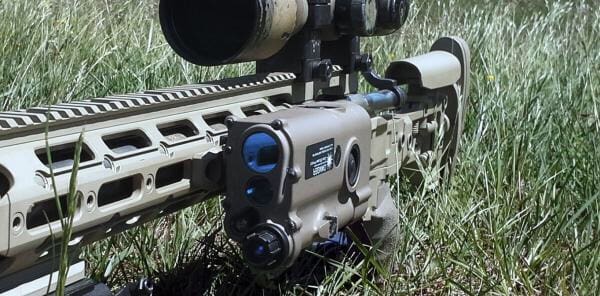
Woodburn stated that the Marines continue to evaluate suppressors for use with the M27 and M4 as well as Medium Machine Guns.
Next year, the Marine Corps will begin fielding the M320A1 40mm Grenade Launcher as a replacement for the M203. It will be used in standalone mode only, and not mounted to the IAR.
The Marine Corps has also adopted the Mk 13 Mod 7, sniper rifle which has been used for many years by USSOCOM. The Marines consider it an interim capability until they can field the Advanced Sniper Rifle in 7.62mm, 300 and 348 Norma Mag in the early 20s. They will also begin to see the 84mm M3E1 Carl Gustaf. The Marines will leverage the seven different rounds SOCOM has developed for the recoilless rifle.
In other joint projects with SOCOM, the Marines continue their support of the 338 NM Lightweight Medium Machine Gun. They are also participating in the Army-led development of the Next Generation Squad Automatic Rifle.
Woodburn finished up by relating that the Marine Corps will begin fielding of the Modular Handgun System in FY19 to replace their legacy pistols.
Yesterday, LTC Mark Owens, USSOCOM’s PM for Ammo, Weapons and Visual Augmentation Systems, briefed SOF Small Arms modernization efforts at NDIA’s annual Armaments Conference. Unfortunately, he only had 10 minutes on the schedule to brief his programs. Consequently, like LTC Owens, I’m going to hit the wave tops and not go over everything on the slides.
The most significant thing he briefed was the Precision Intermediate Caliber Effort which resulted in the adoption of 6.5 Creedmoor, something we’ve covered several times. A lot of effort is being put into producing the Technical Data Package for that ammunition which tells industry how to produce it. He also mentioned that its adoption is cost neutral as it will cost about the same per round as the accurized 7.62 rounds they already procure. Although LTC Owens didn’t discuss it, 6.5 CM machine gun ammo (i.e. linked) is also under development in the event they decide to procure a lightweight assault machine gun in that caliber. One thing he cleared up is that SOCOM considers the 6.5 CM conversion for USASOC’s M110s as a SOF unique program and will pay for their rebarreling.
Additionally, LTC Owens explained the different Upper Receiver options available for the M4A1 Carbine, including the Suppressed Upper Reciever Group which is still in source selection, Personal Defense Weapon which is a .300 BLK Upper, and Upper Receiver enhancements (a similar item is commercially available from Geissele as the URG-I). He also briefly mentioned the Advanced Sniper Rifle, a recently released solicitation. He went in to clarify that development of the ammunition for the 338 Norma Mag Lightweight Medium Machine Gun had begun ahead of the weapon because reducing its weight is the bigger challenge and the weapon can’t be fully developed until the ammo is ready. He finished up this slide with mention of the enhancements for the GLOCK 19s in the command including suppressor, red dot optics and 9mm Speer Gold Dot G2 ammo.
This slide amplifies the ammunition issues already covered, but two other items are of particular interest. First, is the Scalable Offensive Hand Grenade which allows the user to select the charge. Second, is the 9 Bang Flashbang which fires nine times in rapid succession.
Finally, is the Visual Augmentation System update. As you can see, SOCOM is working to adopt a wide variety of new optics.
“Vacation Gone South: Collected Works” is parts I (Vacation Gone South), II (Welcome To The Jungle), III (No Quarter) and IV (A Dead Man Walking) of author Will Brink’s novella E-series in a single printed volume for new readers and fans alike. With additional content added for prior readers of the series, it’s a must read for fans of fast paced gritty thrillers.